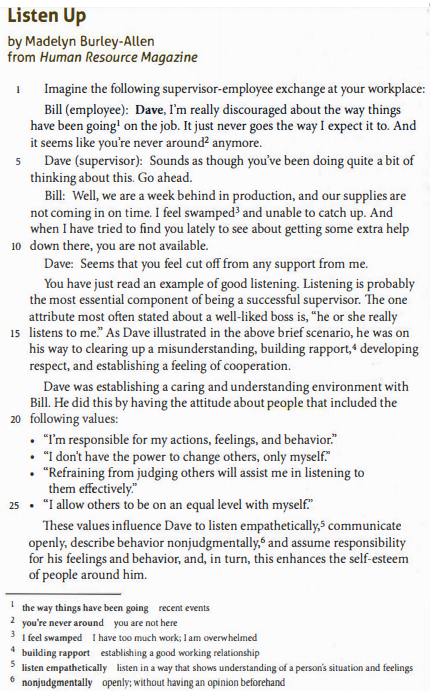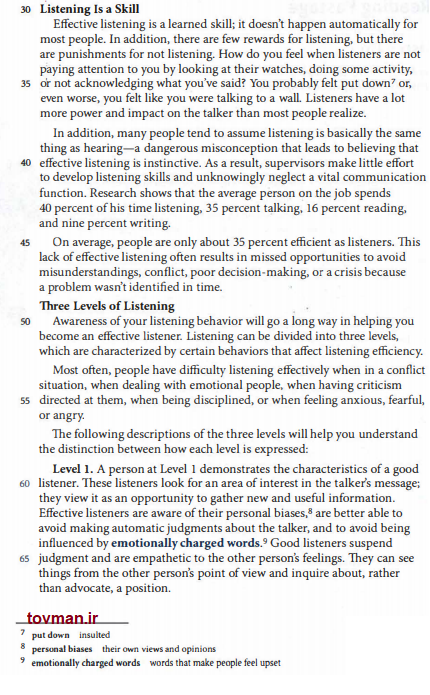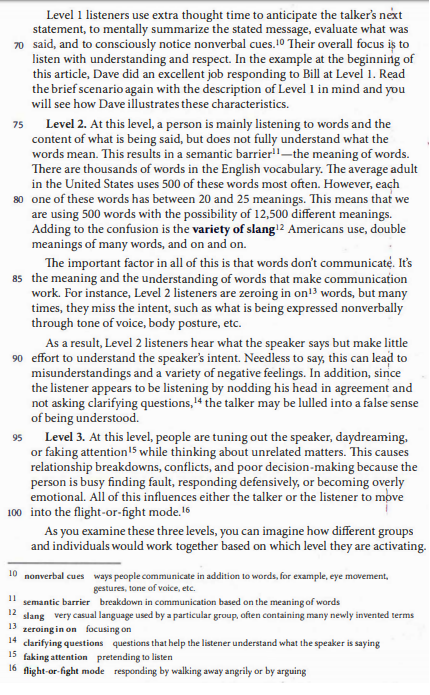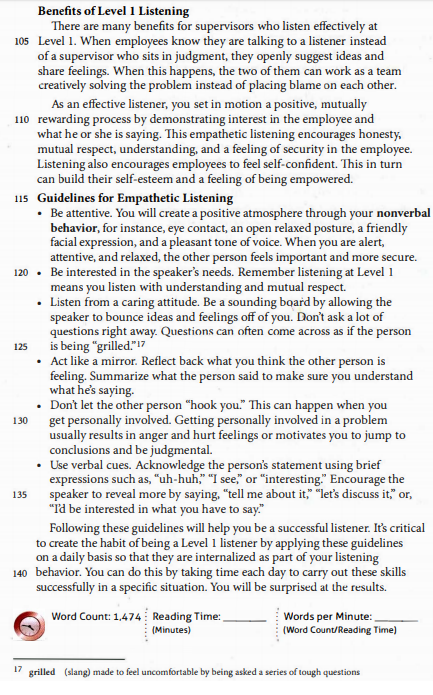
Listen Up
by Madelyn Burley-Allen from Human Resource Magazine
گوش کن
نوشته شده توسط مادلین برلی- آلن از مجله منابع انسانی




Imagine the following supervisor-employee exchange at your workplace: Bill (employee): Dave, I'm really discouraged about the way things have been going۱ on the job. It just never goes the way I expect it to. And it seems like you're never around۲ anymore.
مکالمه سرپرست و کارمند زیر را در محل کار خود تصور کنید: بیل (کارمند): دیو، من واقعا از وقایع اخیر در خصوص کار دلسرد شده ام. آنطور که من انتظار دارم کارها پیش نمی رود. و به نظر می رسد شما هم اینجا نیستید.
Dave (supervisor): Sounds as though you've been doing quite a bit of thinking about this. Go ahead. Bill: Well, we are a week behind in production, and our supplies are not coming in on time. I feel swamped۳ and unable to catch up. And when I have tried to find you lately to see about getting some extra help down there, you are not available.
دیو(سرپرست): به نظر می رسد که شما در مورد این کار زیاد فکر کرده ای. ادامه بده. بیل: خوب ما یک هفته از تولید عقب هستیم و مواد اولیه به موقع نمی رسند. من کارم خیلی زیاد است و قادر نیستم به آنها رسیدگی کنم. و اخیراً وقتی سعی می کند شما راپیدا کنم تا کمک بیشتری از شما بگیرم شما در دسترس نیستید.
Dave: Seems that you feel cut off from any support from me.You have just read an example of good listening. Listening is probably the most essential component of being a successful supervisor. The one attribute most often stated about a well-liked boss is, "he or she really listens to me:' As Dave illustrated in the above brief scenario, he was on his way to clearing up a misunderstanding, building rapport,۴ developing respect, and establishing a feeling of cooperation
دیو: به نظر می رسد شما احساس می کنید هر گونه حمایت من از شما قطع شده است. شما اندکی پیش، نمونه ای از خوب گوش کردن را خواندید. گوش دادن احتمالاً مهمترین مؤلفه سرپرست موفق است. صفتی که بیشتر درباره یک رئیس محبوب و دوست داشتنی، بیان می شود، این است که "او واقعاً به من گوش می دهد:" همانطور که دیو در سناریوی مختصر بالا نشان داد، او در راه از بین بردن سوء تفاهم، ایجاد رابطه کاری خوب، بهبود احترام و ایجاد حس همکاری بود.
Dave was establishing a caring and understanding environment with Bill. He did this by having the attitude about people that included the following values:
• 'Tm responsible for my actions, feelings, and behavior:'
• "I don't have the power to change others, only myself'
• "Refraining from judging others will assist me in listening to them effectively."
• "I allow others to be on an equal level with myself'
دیو در حال ساخت فضای دلسوزانه و قابل درک با بیل بود. او این کار را با داشتن نگرشی در مورد مردم انجام داد که شامل ارزش های زیر است:
- من مسئل اعمال، احساسات و رفتار خوردم هستم
- من جز خودم، قدرت تغییر کسی را ندارم
- خودداری از قضاوت کردن دیگران به من کمک می کند تا به طور موثر به آنها گوش فرا دهم
- من اجازه می دهم دیگران با من در یک سطح برابر باشند
These values influence Dave to listen empathetically, communicate openly, describe behavior nonjudgmentally, and assume responsibility for his feelings and behavior, and, in turn, this enhances the self esteem of people around him
این ارزش ها بر دیو تاثیر می گذارد تا با همدلی گوش فرا دهد، ارتباط باز برقرار کند، بدون پیش داوری رفتار را توصیف کند و مسئولیت احساسات و رفتار خودش را به عهده بگیرد، که این امر به نوبه خود باعث افزایش عزت اطرافیان او می شود.
Listening Is a Skill
Effective listening is a learned skill; it doesn't happen automatically for most people. In addition, there are few rewards for listening, but there are punishments for not listening. How do you feel when listeners are not paying attention to you by looking at their watches, doing some activity,or not acknowledging what you've said? You probably felt put down or, even worse, you felt like you were talking to a wall. Listeners have a lot more power and impact on the talker than most people realize.
گوش کردن یک مهارت است
گوش کردن یک موثر، مهارتی یادگرفتنی است. برای بیشتر مردم، این مهارت به صورت خود کار بوقوع نمی انجامد. علاوه بر این پاداشهای کمی برای گوش کردن هست اما مجازاتهایی برای عدم گوش کردن وجود دارد. چه احساسی دارید وقتی شنوندگان با نگاه کردن به ساعت هایشان، انجام بعضی کارها یا تصدیق نکردن گفته شما؛ به شما توجه نمی کنند؟ احتمالاً احساس می کنید که تحقیر شده اید یا حتی بدتر، در حال حرف زدن با دیوار بوده اید. شنوندگان بیشتر از آنچه که مردم تصور می کنند بر گوینده تاثیر می گذارند.
In addition, many people tend to assume listening is basically the same thing as hearing-a dangerous misconception that leads to believing that effective listening is instinctive. As a result, supervisors make little effort to develop listening skills and unknowingly neglect a vital communication function. Research shows that the average person on the job spends percent of his time listening, ۳۵ percent talking, ۱۶ percent reading, and nine percent writing.
علاوه بر این، بسیاری از افراد تصور می کنند که گوش دادن اساساً همان شنیدن است- برداشت غلطی که منجر به این باور می شود این است که گوش کردن موثر، غریزی است. تحقیقات نشان می دهد که افراد معمولی در سر کار ۳۵ درص از زمان خود را صرف گوش کردن، ۱۶ درصد صحبت کردن و نه درصد صرف نوشتن می کنند.
On average, people are only about ۳۵ percent efficient as listeners. This lack of effective listening often results in missed opportunities to avoid misunderstandings, conflict, poor decision-making, or a crisis because a problem wasn't identified in time
به طور متوسط ، مردم فقط حدود ۳۵ درصد به عنوان شنوندگان کارآمدی هستند. این عدم شنیدن موثر، اغلب منجر به از دست رفتن فرصت ها برای جلوگیری از سوء تفاهم ها، درگیری ها، تصمیم گیری های ضعیف می شود و یا به علت مشخص نشدن به موقع مشکل، موجب بحران می شود.
Three Levels of Listening
so Awareness of your listening behavior will go a long way in helping you become an effective listener. Listening can be divided into three levels, which are characterized by certain behaviors that affect listening efficiency.
سه سطح گوش کردن
بنابراین آگاهی از رفتار گوش کردن به شما کمک می کند تا شنونده کارآمدی شوید. گوش کردن می تواند به سه سطح تقسیم شود که با رفتارهای معینی که بر کارآمدی شنیدن تاثیر می گذارد، مشخص می شوند.
Most often, people have difficulty listening effectively when in a conflict situation, when dealing with emotional people, when having criticism directed at them, when being disciplined, or when feeling anxious, fearful, or angry.
بیشتر اوقات، وقتی افراد در یک موقعیت مناقشه و کشمکش قرار دارند، یا وقتی در تعامل با افراد عاطفی قرار می گیرند یا وقتی به صورت مستقیم از آنها انتقاد می شود یا وقتی تادیب شده یا وقتی احساس اضطراب دارند یا عصبانی هستند؛ مشکلاتی در شنیدن کارآمد دارند.
The following descriptions of the three levels will help you understand the distinction between how each level is expressed:
توضیحات زیر در مورد این سه سطح، به شما کمک می کند تا تمایز بین نحوه بیان هر سطح را درک کنید:
Level ۱. A person at Level ۱ demonstrates the characteristics of a good listener. These listeners look for an area of interest in the talker's message; they view it as an opportunity to gather new and useful information. Effective listeners are aware of their personal biases, are better able to avoid making automatic judgments about the talker, and to avoid being influenced by emotionally charged words. Good listeners suspend judgment and are empathetic to the other person's feelings. They can see things from the other person's point of view and inquire about, rather than advocate, a position.
سطح ۱. شخص در سطح ۱ ویژگی های شنونده خوب را نشان می دهد. این شنوندگان به دنبال منطقه مورد علاقه در پیام گوینده هستند. آنها آن را، فرصتی برای جمع آوری اطلاعات جدید و مفید می دانند. شنوندگان واقعی از تعصبات خود، آگاه هستند و بهتر می توانند از قضاوت خودکار در مورد گوینده اجتناب کنند و از اینکه تحت تاثیر کلماتی که موجب ناراحتی آنها می شود، واقع شوند، اجتناب کنند. شنوندگان خوب قضاوت را به تعویق انداخته و نسبت به احساسات شخص دیگر همدلی می کنند. آنها می توانند چیزها را از نقطه نظر دیگران ببینند و به جای طرفداری از یک موضع، در مورد آن سوال کنند.
Level ۱ listeners use extra thought time to anticipate the talker's next statement, to mentally summarize the stated message, evaluate what was said, and to consciously notice nonverbal cues. Their overall focus is to listen with understanding and respect. In the example at the beginning of this article, Dave did an excellent job responding to Bill at Level ۱. Read . the brief scenario again with the description of Level ۱ in mind and you will see how Dave illustrates these characteristics
شنوندگان سطح ۱ زمان بیشتری برای فکر کردن بکار می برند تا جمله بعدی گوینده را پیش بینی کرده و بطور ذهنی پیام بیان شده را خلاصه کرده و آنچه گفته شده است را ارزیابی کنند و بطور آگاهانه به نشانه های غیرکلامی توجه می کنند. تمرکز کلی آنها گوش کردن با درک و احترام است. در مثال ابتدای این مقاله ، دیو کار بسیار خوبی در پاسخ به بیل در سطح ۱ انجام داد. بار دیگر سناریو کوتاه را با توضیحات سطح ۱ در ذهن بخوانید؛ خواهید دید که چگونه دیو این خصوصیات را نشان می دهد.
Level ۲. At this level, a person is mainly listening to words and the content of what is being said, but does not fully understand what the words mean. This results in a semantic barrier۱۱-the meaning of words. There are thousands of words in the English vocabulary. The average adult in the United States uses ۵۰۰ of these words most often. However, each one of these words has between ۲۰ and ۲۵ meanings. This means that we are using ۵۰۰ words with the possibility of ۱۲,۵۰۰ different meanings. Adding to the confusion is the variety of slang۱۲ Americans use, double meanings of many words, and on and on
در این سطح، فرد به طور عمده به کلمات و محتوای گفته شده گوش می دهد، اما کاملاً معنی کلمات را نمی فهمد. این منجر به یک سد معنایی - معنی کلمات می شود. هزاران کلمه در واژگان انگلیسی وجود دارد. بزرگسالان معمولی در ایالات متحده بیشتر اوقات از ۵۰۰ لغت آن استفاده می کنند. اما هر کدام از این لغات ۲۰ تا ۲۵ معنی دارند. این بدین معنی است که ما از ۵۰۰ لغت با امکان ۱۲۵۰۰ معنای مختلف استفاده می کنیم. در هم و بر همی انواع اصطلاحات عامیانه ای که آمریکائی ها استفاده می کنند، معانی دوتایی بسیاری از لغات و غیره را هم به آن اضافه کنید.
The important factor in all of this is that words don't communicate. It's the meaning and the understanding of words that make communication work. For instance, Level ۲ listeners are zeroing in on words, but many times, they miss the intent, such as what is being expressed none verbally through tone of voice, body posture, etc.
عامل مهم در همه اینها این است که کلمات ارتباط برقرار نمی کنند. این معنی و درک کلمات است که ارتباطات را عملی می کند. به عنوان مثال ، شنوندگان سطح ۲ بر روی کلمات تمرکز می کنند، اما بسیاری اوقات قصد و نیت گوینده را از دست می دهند، مانند آنچه که به صورت غیر کلامی از طریق تنِ صدا، حالت بدن و غیره بیان می شود.
little effort to understand the speaker's intent. Needless to say, this can leap to misunderstandings and a variety of negative· feelings. In addition, since the listener appears to be listening by nodding his head in agreement and not asking clarifying questions, the talker may be lulled into a false sense of being understood.
در نتیجه، شنوندگان سطح ۲ حرف های گوینده را می شنوند اما تلاش کمی برای درک منظور گوینده می کنند. نیازی به گفتن نیست، که این می تواند، منجر به سوء تفاهات و انواع احساسات منفی شود. علاوه بر این، از آنجا که شنونده با تکان دادن سرش بعنوان موافقت، تظاهر به گوش دادن می کند و سوالات روشن کننده نمی پرسد، گوینده ممکن است با این حس اشتباه که منظورش را فهمیده اند، ساکت شود.
Level ۳. At this level, people are tuning out the speaker, daydreaming,or faking attention ۱۵ while thinking about unrelated matters. This causes relationship breakdowns, conflicts, and poor decision-making because the person is busy finding fault, responding defensively, or becoming overly emotional. All of this influences either the talker or the listener to move into the flight-or-fight mode
سطح ۳. در این سطح افراد توجه خود را از گوینده باز داشته، خیالبافی کرده یا وانمود می کنند که در حال گوش کردن هستند درحالیکه در مورد موضوعات غیر مرتبط فکر می کنند و این باعث خراب شدن روابط، درگیری و تصمیم گیری های ضعیف می شود زیرا فرد در حال پیدا کردن اشتباه، پاسخ دادن تدافعی، یا بیش از حد احساساتی شدن است. همه اینها گوینده و شنونده را تحت تاثیر قرار داده تا وارد مشاجره و نزاع شوند.
As you examine these three levels, you can imagine how different groups and individuals would work together based on which level they are activating.
وقتی این سه سطح را بررسی می کنید، می توانید تصور کنید چگونه افراد و گروههای مختلف بر مبنای سطحی که آنها فعال هستند، با هم کار می کنند.
Benefits of Level ۱ Listening
There are many benefits for supervisors who listen effectively at Level ۱. When employees know they are talking to a listener instead of a supervisor who sits in judgment, they openly suggest ideas and share feelings. When this happens, the two of them can work as a team creatively solving the problem instead of placing blame on each other
مزایای گوش دادن سطح ۱
فواید بسیاری برای سرپرست هایی که در سطح ۱ گوش می دهند وجود دارد. وقتی کارمندان می دانند به جای یک ناظر که در حال قضاوت است با یک شنونده صحبت می کنند، آنها آشکارا ایده ها را مطرح می کنند و احساسات را با یکدیگر به اشتراک می گذارند. وقتی این اتفاق بیفتد، این دو نفر می توانند به جای اینکه یکدیگر را سرزنش کنند، به طور خلاقانه، به عنوان یک تیم برای حل مسئله کار می کنند.
As an effective listener, you set in motion a positive, mutually rewarding process by demonstrating interest in the employee and what he or she is saying. This empathetic listening encourages honesty, mutual respect, understanding, and a feeling of security in the employee. Listening also encourages employees to feel self-confident. This in turn can build their self-esteem and a feeling of being empowered.
شما به عنوان یک شنونده خوب، با نشان دادن علاقه به کارمند و آنچه او می گوید روش مثبتی را به جریان بیندازید تا مراحل کار را با موفقیت متقابل به انجام برسانید. این گوش دادن دلسوزانه موجب تقویت صداقت، احترام متقابل، درک و احساس امنیت در کارمند می شود. گوش دادن همچنین احساس اعتماد به نفس را در کارمندان تقویت می کند. و این به نوبه خود می تواند احساس قدرت و عزت نفس را در آنها ایجاد کند.
Guidelines for Empathetic Listening
• Be attentive. You will create a positive atmosphere through your nonverbal behavior, for instance, eye contact, an open relaxed posture, a friendly facial expression, and a pleasant tone of voice. When you are alert, attentive, and relaxed, the other person feels important and more secure.
رهنمودهایی برای گوش کردن همدلانه
- هشیار باشید. شما می توانید با رفتار غیر کلامی خود ، مثلاً تماس چشمی ، حالتی آرام ، حالت چهره دوستانه و تن صدای دلپذیر، یک فضای مثبت ایجاد کنید. وقتی هوشیار ، باتوجه و آرام هستید، شخص دیگر احساس اهمیت و امنیت بیشتری می کند.
• Be interested in the speaker's needs. Remember listening at Level ۱ means you listen with understanding and mutual respect
• به نیازهای گوینده علاقه مند شوید. به یاد داشته باشید که گوش دادن در سطح ۱ به این معنی است که با درک و احترام متقابل گوش می دهید.
• Listen from a caring attitude. Be a sounding board by allowing the speaker to bounce ideas and feelings off of you. Don't ask a lot of questions right away. Questions can often come across as if the person is being "grilled
به گوینده اجازه دهید نظرات و احساساتش را دوستانه با شما در میان بگذارد و بدین وسیله عامل انتشار عقاید باشید. فوراً سوالات زیادی نپرسید. به نظر می رسد سوالات باعث احساس ناراحتی آن شخص می شود.
• Act like a mirror. Reflect back what you think the other person is feeling. Summarize what the person said to make sure you understand what he's saying.
- همانند آینه عمل کنید. آنچه را که فکر می کنید شخصی احساس می کند بازتاب دهید. آنچه را که شخص گفته است خلاصه کنید تا مطمئن شوید که او چه می گوید.
• Don't let the other person "hook you:' This can happen when you get personally involved. Getting personally involved in a problem usually results in anger and hurt feelings or motivates you to jump to conclusions and be judgmental.
- اجازه ندهید شخص دیگری شما را درگیر کند: "این مسئله می تواند هنگامی رخ دهد که شخصاً درگیر شوید. شخصاً درگیر یک مشکل شدن، معمولاً منجر به عصبانیت و صدمه زدن به احساسات می شود و یا شما را تحریک می کند تا نتیجه گیری و داوری کنید.
• Use verbal cues. Acknowledge the person's statement using brief expressions such as, "uh-huh:' "I see:' or "interesting:' Encourage the speaker to reveal more by saying,tell me about it; let's discuss it, or, I'd be interested in what you have to say.
از نشانه های کلامی استفاده کنید. اظهارات شخص را با استفاده از عبارات مختصر همانند آه ها، می فهمم یا جالب است، تصدیق کنید. با گفتن در مورد آن به من بگو یا بیا در موردش بحث کنیم یا من به آنچه باید بگویید علاقه مندم؛ گوینده را تشویق کنید تا موارد بیشتری را بیان کند.
Following these guidelines will help you be a successful listener. It's critical to create the habit of being a Level I listener by applying these guidelines on a daily basis so that they are internalized as part of your listening behavior. You can do this by taking time each day to carry out these skills successfully in a specific situation. You will be surprised at the results.
پیروی از این دستورالعمل ها به شما کمک می کند تا یک شنونده موفق باشید. بسیار مهم است که با استفاده از این رهنمودها بطور روزانه، گوش کردن سطح ۱را ایجاد کنید تا آنها به عنوان بخشی از رفتار شنیداری شما درونی شوند. شما می توانید این کار را با صرف وقت در هر روز انجام دهید تا در یک موقعیت خاص این مهارت ها را با موفقیت انجام دهید. شما از نتایج شگفت زده خواهید شد.

